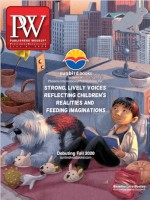Eileen Robinson’s quest to publish books for reluctant readers began at home. At age eight, her son associated reading with school and was struggling to find books that interested him. After speaking to his friends and their parents, Robinson, an editor and educator, learned that her son wasn’t alone in his resistance to reading for pleasure. “I wondered where all that early love of reading went,” Robinson says. “For boys between the ages of eight and 12, that’s when reading scores begin to drop significantly.”
Robinson began to investigate. She learned it wasn’t that her son disliked reading—he was just bored by most fiction. He liked books about “anything that was ‘real,’ ” she says, “or adventures with images,” but they were few and far between on the bookstore shelves at the time. So she often found herself buying YA titles. “He’d read out loud to me and ask what certain words meant,” Robinson says. “He was eager to have a conversation about books, but certain fiction held a prickliness for him—he just wasn’t interested.”
When she searched for illustrated fiction or nonfiction titles targeted at boys, Robinson found limited options. “Graphic novels for readers ages eight to 12 hadn’t yet found their footing in bookstores, as they have today,” she says. And so Move Books was born— “moving boys to read,” Robinson says.
Despite its original mission, Move Books in no way excludes girls. “In general,” Robinson says, “what draws boys in emotionally can be different from what draws girls, which is why I think authors like Jon Scieszka, of the Guys Read series, or books written in verse like Kwame Alexander’s The Crossover are so successful. And visuals also help—whether broken up with line drawings like Jeff Kinney’s Diary of a Wimpy Kid series or with pages of panels like graphic novels, such as Jerry Craft’s New Kid.”
“I would like to publish graphic novels,” says Robinson, “but they are currently cost-prohibitive. However, I hope to soon publish graphic stories of 100 to 150 pages for this age group. I think they would love it!”
Move Books also looks to publish stories that can grow alongside readers. The majority of acquisitions have been series, which Robinson says is “a great way to get readers invested, especially middle graders. Once they are hooked, they tend to own it; they feel like it was made for them and they look forward to each installment.”
The publisher’s series include The Mapmaker’s Sons by V. L. Burgess, about an ordinary boy tasked with finding a powerful weapon to save the world, and, more recently, The Lost Tribes by Christine Taylor-Butler, about kids who discover their parents may not be from this planet; The Lost Tribes will have its third installment published by next year. Paul Greci’s Surviving Bear Island, out now, features the same young protagonist as a second novel, Follow the River, that will be out late this summer, and the publisher’s first stand-alone title, HUM by William Thomas, will be published this fall. “HUM is about a young boy who, after moving from the city to a small town where his grandmother thinks he’ll make more friends, discovers he has a unique gift—he can communicate with llamas. This is a departure from what we normally look for,” Robinson says. “It’s more of a ‘quiet’ adventure.”
Despite the uncertainty facing families, teachers, and the publishing industry this summer, Move Books is looking ahead. To help readers connect with each other and their favorite authors, Move is offering “summer get-togethers” remotely, and once school is back in session, Robinson says Move has plenty of potential for curriculum tie-ins. “The Lost Tribes is full of science and social studies and touches on many other subjects,” she says. “Each book can be used to advance students’ critical thinking skills, especially when put together like one big puzzle.”
Move Books has evolved significantly since its launch, and Robinson has learned a great deal in the process. To develop a deeper understanding of their audience, she and her team continue to seek feedback from kids, parents, booksellers, and librarians. “Why not entangle boy readers in survival, mayhem, and adventure to get them not only reading but learning,” Robinson says.
She has a few words of advice for parents, particularly those who may be homeschooling or have reluctant readers. “Let them choose,” she says. “Let them gravitate toward what interests them and get them talking about books. That’s our focus as a small independent publisher.”



 Volume 267
Issue 23
06/08/2020
Volume 267
Issue 23
06/08/2020





